根据数值对Pandas数据框架的行或列进行排序
在这篇文章中,我们将讨论如何在Pandas数据框架中根据数值对行或列进行排序。Pandas sort_values()方法对一个数据框架按照所传递的列的升序或降序进行排序。它与Python的排序函数不同,因为它不能对数据框进行排序,也不能选择特定的列。
语法:
DataFrame.sort_values(by, axis=0, ascending=True, inplace=False, kind=’quicksort’, na_position=’last’)
参数:
这个方法将接受以下参数。
by: 单一/列的列名来对数据框架进行排序。
axis:0或’索引’为行,1或’列’为列。
ascending: 布尔值,如果为真,则以升序排列数据框。
inplace: 布尔值。如果为真,则在传递的数据框中进行修改。
kind: 字符串,可以有三个输入(‘quicksort’, ‘mergesort’ or ‘heapsort’)用于排序数据帧的算法。
na_position:接受两个字符串输入’last’或’first’来设置Null值的位置。默认为 “最后”。
返回类型。返回一个排序的数据框,其尺寸与函数调用者的数据框相同。
现在,让我们创建一个样本数据框架。
# import pandas library as pd
import pandas as pd
# List of Tuples
students = [('Ankit', 22, 'Up', 'Geu'),
('Ankita', 31, 'Delhi', 'Gehu'),
('Rahul', 16, 'Tokyo', 'Abes'),
('Simran', 41, 'Delhi', 'Gehu'),
('Shaurya', 33, 'Delhi', 'Geu'),
('Harshita', 35, 'Mumbai', 'Bhu' ),
('Swapnil', 35, 'Mp', 'Geu'),
('Priya', 35, 'Uk', 'Geu'),
('Jeet', 35, 'Guj', 'Gehu'),
('Ananya', 35, 'Up', 'Bhu')
]
# Create a DataFrame object from
# list of tuples with columns
# and indices.
details = pd.DataFrame(students, columns =['Name', 'Age',
'Place', 'College'],
index =[ 'b', 'c', 'a', 'e', 'f',
'g', 'i', 'j', 'k', 'd'])
# show the dataframe
details
输出:
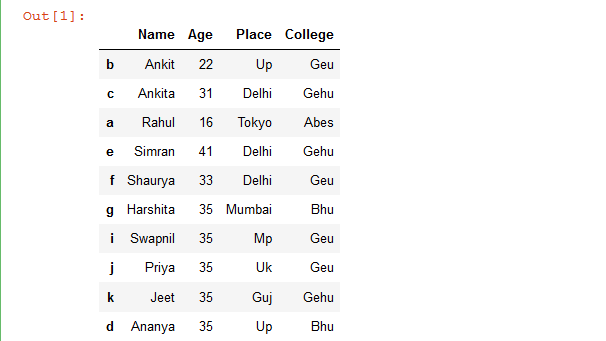
示例1:根据单列对数据框架行进行排序。
# import pandas library as pd
import pandas as pd
# List of Tuples
students = [('Ankit', 22, 'Up', 'Geu'),
('Ankita', 31, 'Delhi', 'Gehu'),
('Rahul', 16, 'Tokyo', 'Abes'),
('Simran', 41, 'Delhi', 'Gehu'),
('Shaurya', 33, 'Delhi', 'Geu'),
('Harshita', 35, 'Mumbai', 'Bhu' ),
('Swapnil', 35, 'Mp', 'Geu'),
('Priya', 35, 'Uk', 'Geu'),
('Jeet', 35, 'Guj', 'Gehu'),
('Ananya', 35, 'Up', 'Bhu')
]
# Create a DataFrame object from
# list of tuples with columns
# and indices.
details = pd.DataFrame(students, columns =['Name', 'Age',
'Place', 'College'],
index =[ 'b', 'c', 'a', 'e', 'f',
'g', 'i', 'j', 'k', 'd'])
# Sort the rows of dataframe by 'Name' column
rslt_df = details.sort_values(by = 'Name')
# show the resultant Dataframe
rslt_df
输出:

示例2:根据多列对数据框架行进行排序。
# import pandas library as pd
import pandas as pd
# List of Tuples
students = [('Ankit', 22, 'Up', 'Geu'),
('Ananya', 31, 'Delhi', 'Gehu'),
('Rahul', 16, 'Tokyo', 'Abes'),
('Simran', 41, 'Delhi', 'Gehu'),
('Shaurya', 33, 'Delhi', 'Geu'),
('Harshita', 35, 'Mumbai', 'Bhu' ),
('Priya', 35, 'Mp', 'Geu'),
('Priya', 34, 'Uk', 'Geu'),
('Jeet', 35, 'Guj', 'Gehu'),
('Ananya', 35, 'Up', 'Bhu')
]
# Create a DataFrame object from
# list of tuples with columns
# and indices.
details = pd.DataFrame(students, columns =['Name', 'Age',
'Place', 'College'],
index =[ 'b', 'c', 'a', 'e', 'f',
'g', 'i', 'j', 'k', 'd'])
# sort Dataframe rows based on a 'Name' & 'Age' columns
# if duplicate value is present in 'Name' column
# then sorting will be done according to 'Age' column
rslt_df = details.sort_values(by = ['Name', 'Age'])
# show the resultant Dataframe
rslt_df
输出:
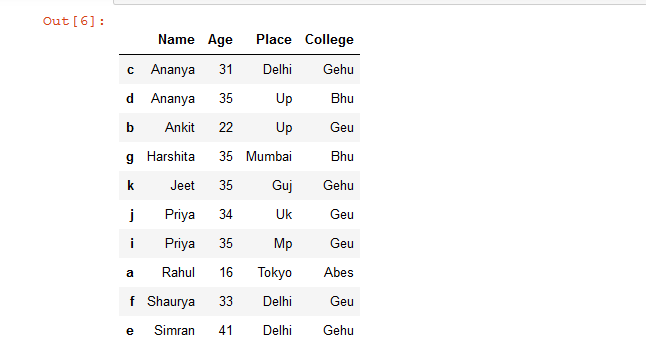
示例3:根据降序的列对数据框架的行进行排序。
# import pandas library as pd
import pandas as pd
# List of Tuples
students = [('Ankit', 22, 'Up', 'Geu'),
('Ananya', 31, 'Delhi', 'Gehu'),
('Rahul', 16, 'Tokyo', 'Abes'),
('Simran', 41, 'Delhi', 'Gehu'),
('Shaurya', 33, 'Delhi', 'Geu'),
('Harshita', 35, 'Mumbai', 'Bhu' ),
('Priya', 35, 'Mp', 'Geu'),
('Priya', 34, 'Uk', 'Geu'),
('Jeet', 35, 'Guj', 'Gehu'),
('Ananya', 35, 'Up', 'Bhu')
]
# Create a DataFrame object from
# list of tuples with columns
# and indices.
details = pd.DataFrame(students, columns =['Name', 'Age',
'Place', 'College'],
index =[ 'b', 'c', 'a', 'e', 'f',
'g', 'i', 'j', 'k', 'd'])
# sort Dataframe rows based on "Name'
# column in Descending Order
rslt_df = details.sort_values(by = 'Name', ascending = False)
# show the resultant Dataframe
rslt_df
输出:
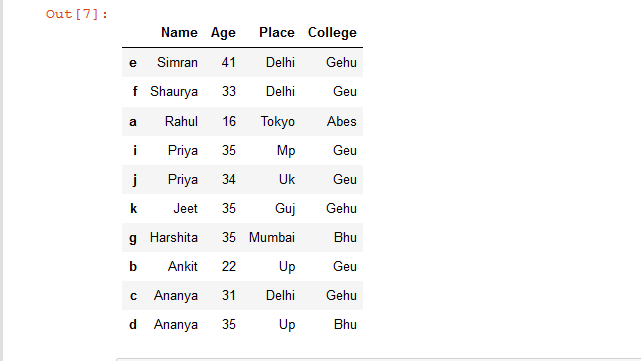
例子4:根据Place中的一列对Dataframe的行进行排序。
# import pandas library as pd
import pandas as pd
# List of Tuples
students = [('Ankit', 22, 'Up', 'Geu'),
('Ananya', 31, 'Delhi', 'Gehu'),
('Rahul', 16, 'Tokyo', 'Abes'),
('Simran', 41, 'Delhi', 'Gehu'),
('Shaurya', 33, 'Delhi', 'Geu'),
('Harshita', 35, 'Mumbai', 'Bhu' ),
('Priya', 35, 'Mp', 'Geu'),
('Priya', 34, 'Uk', 'Geu'),
('Jeet', 35, 'Guj', 'Gehu'),
('Ananya', 35, 'Up', 'Bhu')
]
# Create a DataFrame object from
# list of tuples with columns
# and indices.
details = pd.DataFrame(students, columns =['Name', 'Age',
'Place', 'College'],
index =[ 'b', 'c', 'a', 'e', 'f',
'g', 'i', 'j', 'k', 'd'])
# Sort the rows of dataframe by 'Name'
# column inplace
details.sort_values(by = 'Name', inplace = True)
# show the resultant Dataframe
details
输出:
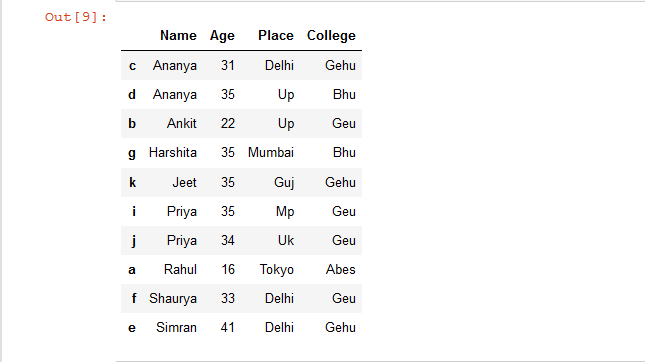
**让我们看看另一个简单的数据框架,我们能够根据行来对列进行排序。
# import pandas library as pd
import pandas as pd
# List of Tuples
students = [
(75, 50, 60, 70),
(75, 55, 65, 75),
(75, 35, 45, 25),
(75, 90, 60, 70),
(76, 90, 70, 60),
(90, 80, 70, 60),
(65, 10, 30, 20)
]
# Create a DataFrame object from
# list of tuples with columns
# and indices.
details = pd.DataFrame(students, columns =['Hindi', 'Math',
'Science', 'English'],
index = ['Ankit', 'Rahul', 'Aishwarya',
'Shivangi', 'Priya', 'Swapnil',
'Shaurya'])
# show the dataframe
details
输出:
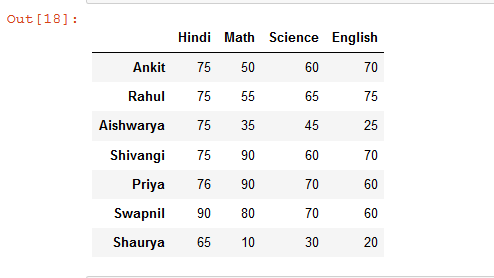
示例1:根据单一行对数据框架的列进行排序。
# import pandas library as pd
import pandas as pd
# List of Tuples
students = [
(75, 50, 60, 70),
(75, 55, 65, 75),
(75, 35, 45, 25),
(75, 90, 60, 70),
(76, 90, 70, 60),
(90, 80, 70, 60),
(65, 10, 30, 20)
]
# Create a DataFrame object from
# list of tuples with columns
# and indices.
details = pd.DataFrame(students, columns =['Hindi', 'Math',
'Science', 'English'],
index = ['Ankit', 'Rahul', 'Aishwarya',
'Shivangi', 'Priya', 'Swapnil',
'Shaurya'])
# sort columns of a Dataframe based
# on a 'Shivangi' row
rslt_df = details.sort_values(by = 'Shivangi', axis = 1)
# show the dataframe
rslt_df
输出:
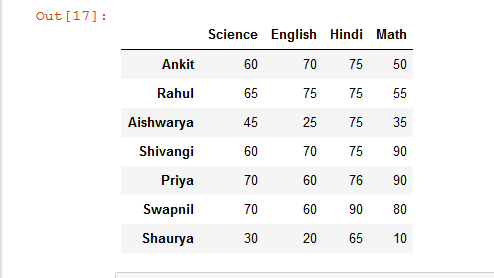
示例2:以降序方式对数据框架中的列进行排序,基于单一行。
# import pandas library as pd
import pandas as pd
# List of Tuples
students = [
(75, 50, 60, 70),
(75, 55, 65, 75),
(75, 35, 45, 25),
(75, 90, 60, 70),
(76, 90, 70, 60),
(90, 80, 70, 60),
(65, 10, 30, 20)
]
# Create a DataFrame object from
# list of tuples with columns
# and indices.
details = pd.DataFrame(students, columns =['Hindi', 'Math',
'Science', 'English'],
index = ['Ankit', 'Rahul', 'Aishwarya',
'Shivangi', 'Priya', 'Swapnil',
'Shaurya'])
# Sort columns of a dataframe in descending order
# based on a 'Shivangi' row
rslt_df = details.sort_values(by = 'Shivangi', axis = 1, ascending = False)
rslt_df
输出:
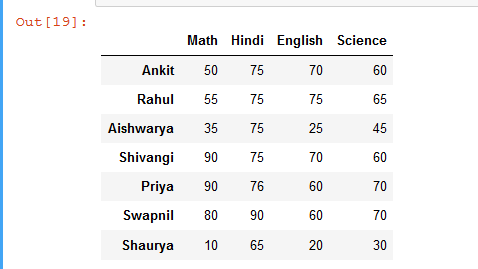
示例3:根据多行对数据框架的列进行排序。
# import pandas library as pd
import pandas as pd
# List of Tuples
students = [
(75, 50, 60, 70),
(75, 55, 65, 75),
(75, 35, 45, 25),
(75, 90, 60, 70),
(76, 90, 70, 60),
(90, 80, 70, 60),
(65, 10, 30, 20)
]
# Create a DataFrame object from
# list of tuples with columns
# and indices.
details = pd.DataFrame(students, columns =['Hindi', 'Math',
'Science', 'English'],
index = ['Ankit', 'Rahul', 'Aishwarya',
'Shivangi', 'Priya', 'Swapnil',
'Shaurya'])
# sort Dataframe columns based on a 'Shivangi' & 'Priya' rows
# if duplicate value is present in 'Shivangi' row
# then sorting will be done according to 'Priya' row
rslt_df = details.sort_values(by = ['Shivangi', 'Priya'], axis = 1)
rslt_df
输出:
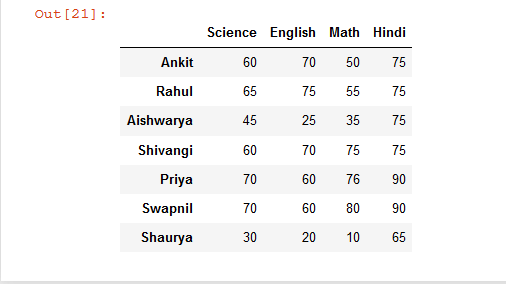
 极客教程
极客教程